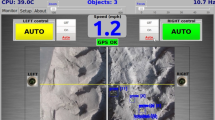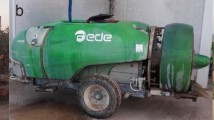Abstract
Vegetation indices (VI) obtained by optical sensors have a positive correlation with various attributes of cotton plant growth. This work is aimed at evaluating the variable rate application of plant growth regulator (PGR) and fruit ripener on zones defined by VI and penological measurements using a sprayer equipped with a relatively low cost electronic flow controller on the height, percentage of open fruits, yield and net income. The work was done in a 92 ha field during crop seasons 2012/2013 and 2013/2014, and in a 202 ha field, during the crop season 2014/2015. Two spray applications were made using variable rate technology (VRT) of the PGR and one fruit ripener, in both harvest seasons, according to three VI classes formed by a previous mapping. The uniformity of the cotton height and opened fruits contribute to a similar yield across zones. Uniform plant height facilitates cotton harvest. The ripener helps to ensure all the cotton is ready to be harvested at the same time. In this trial, use of VRT technique to manage the PGR and fruit ripener application increased net income by US$152.28 ha−1, but this estimate is based on yields that are not statistically significantly different from the control. This research confirms that PGR and fruit ripener can be sufficiently managed with an electronic flow controller to result in more uniform cotton plant height and yields within fields, but it leaves open the question of whether VRT PGR is profitable even with the lower cost electronic flow controller.









Similar content being viewed by others
References
Amaral, L. R., Molin, J. P., Portz, G., Finazzi, F. B., & Cortinove, L. (2015). Comparison of crop canopy reflectance sensors used to identify sugarcane biomass and nitrogen status. Precision Agriculture, 16(1), 15–28.
Antuniassi, U. R., Baio, F. H. R., & Sharp, T. C. (2015). Precision Agriculture. (In Portuguese.). In Abrapa (Ed.), Algodão no Cerrado do Brasil (pp. 767–806). 3rd ed. Brasília: Gráfica e Editora Positiva.
ASAE (2000). Agricultural machinery management data. St. Joseph, ASAE Standards, 349–359. Retrived March 3, 2017 from http://www.nrcs.usda.gov/Internet/FSE_DOCUMENTS/16/nrcs143_009503.pdf.
Baio, F. H. R., & Antuniassi, U. R. (2011). Electronic control systems and path control to field sprayers (In Portuguese). In U. R. Antuniassi & W. Boller (Eds.), Application technology to annual crops (pp. 123–142). Passo Fundo: Aldeia Norte.
Baio, F. H. R., Leal, A. J. F., Neves, D. C., Souza, H. B., & Gasparelli, D. L. (2015a). Immediate response: variable rate application in itself is already an expressive technological advance for crops (In Portugese). Cultivar Máquinas, 8(154), 12–18.
Baio, F. H. R., Scarpin, I. M., & Silva, E. R. (2015b). Water sensitive paper and alternative photographic in deposition tests of droplets. (In Portuguese, with English abstract). Brazilian Journal of Biosystems Engineering, 9(4), 339–347.
Conab (2016) Proposta de Preços Mínimos 2013/2014. Retrived March 3, 2016 from http://www.conab.gov.br/OlalaCMS/uploads/arquivos/13_11_22_15_41_10_pm_verao_13_14.pdf.
Di Rienzo, J. A., Casanoves, F., Balzarini, M. G., Gonzalez, L., Tablada, M., & Robledo, C. W. (1998). InfoStat. Retrived December 15, 2015 from http://www.infostat.com.ar.
Dodds, D. M., Banks, J. C., Barber, L. T., Boman, R. K., Brown, S. M., Edmisten, K. L., et al. (2010). Beltwide evaluation of commercially available plant growth regulators. Journal of Cotton Science, 3, 119–130.
Echer, F. R., Rosolem, C. A., & Werle, R. (2013). Dose estimation of growth regulator to be applied to cotton as a function of its growth. (In Portuguese). Cuiabá/MT: Instituto Mato-Grossense do Algodão, Brasil.
Embrapa. (2006). Brazilian soil classification system. (In Portuguese) (2nd ed.). Rio de Janeiro, Brazil: EMBRAPA.
Ferreira, D. F. (2011). Sisvar: a computer statistical analysis system. Ciência e Agrotecnologia, 5(6), 1039–1042.
Ferreira, A. C. B., & Lamas, F. M. (2006). Use of plant growth regulators, CW defoliants, desiccants and fruit ripeners on cotton crop. (In Portuguese), Campina Grande/PB: EMBRAPA (Circular Técnica 95).
Freitas, R. S., Tomaz, M. A., Ferreira, L. R., Berger, P. G., Pereira, C. J., & Cecon, P. R. (2006). Growth cotton submitted to trifloxysulfuron-sodium herbicide (In Portuguese). Planta Daninha, 24(1), 123-129.
Griffin, T. W., & Lowenberg-DeBoer, J. (2005). Worldwide adoption and profitability of precision agriculture Implications for Brazil. Politica Agrícola, 14(4), 20–37.
Gu, S., Evers, J. B., Zhang, L., Mao, L., Vos, J., & Li, Z. (2014). Modelling the structural response of cotton plants to mepiquat chloride and population density. Annals of Botany, 114(4), 877–887.
Hunt, D. (2007) Farm power and machinery management. 10th ed. Waveland Press. 376p.
Iqbal, J., Read, J. J., & Whisler, F. D. (2013). Using remote sensing and soil physical properties for predicting the spatial distribution of cotton lint yield. Turkish Journal of Field Crops, 18(2), 158–165.
Jasper, J., Reusch, S., & Link, A. (2009). Active sensing of the N status of wheat using optimized wavelength combination—impact of seed rate, variety and growth stage. In 7th European Conference on Precision Agriculture. Proceedings. Wageningen, Netherlands. (CD-ROM).
Kay, R., Edwards, W., & Duffy, P. A. (2015). Farm Management. 8th ed. McGraw-Hill Education. 480p.
Lamas, F. M., & Ferreira, A. C. B. (2015). Growth regulators, defoliants and fruit ripeners. (In Portuguese.). In ABRAPA (Ed.), Algodão no Cerrado do Brasil (pp. 559-582). 3rd ed. Brasília: Gráfica e Editora Positiva.
Lamas, F. M., Ferreira, A. C. B., & Bogiani, J. C. (2013). Points to consider in the growth regulator management in cotton crops. (In Portuguese), Dourados/MS: EMBRAPA (Comunicado Técnico 192).
Lowenberg-DeBoer, J. (2000) Economic Analysis of Precision Farming. In Borem et al. (Ed.), In: Agricultura de Precisao (pp. 147-172). Vicosa: Federal University of Vicosa.
Marur, C. J., & Ruano, O. (2001). A reference system for determination of developmental stages of upland cotton. Revista Brasileira de Oleaginosas e Fibrosa, 5(2), 313–317.
Montomiya, A. V. A., Valente, I. M. Q., Molin, J. P., Motomiya, W. R., Biscaro, G. A., & Jordan, R. A. (2014). Vegetation index in cotton under rates of nitrogen and growth regulator. (In Portuguese, with English abstract). Revista. Semina, 35(1), 169–178.
Oosterhuis, D. M. (1999). Growth and development of the cotton plant. In E. Cia, E. C. Freire, & W. J. Santos (Eds.), Cultura do algodoeiro (Cotton crop) (pp. 35–55). Piracicaba, Brazil: Potafos.
Portz, G., Molin, J. P., & Jasper, J. (2012). Active crop sensor to detect variability of nitrogen supply and biomass on sugarcane fields. Precision Agriculture, 13(1), 33–44.
Portz, G., Vilanova, N. S. Jr., Trevisan, R. G., Molin, J. P., Portz, C., & Posada, L. V. (2014). Cotton field relations of plant height to biomass accumulation and n-uptake on conventional and narrow row systems. In 12th International Conference on Precision Agriculture. Proceedings… Sacramento, USA. (CD-ROM).
Rosolem, C. A., Oosterhuis, D. M., & Souza, F. S. D. (2013). Cotton response to mepiquat chloride and temperature. Scientia Agricola, 70(2), 82–87.
Salvador, A., & Antuniassi, U. R. (2011). Multispectral image for management zones identification and variable rate application in cotton areas. (In Portuguese, with English abstract). Revista Energia na. Agricultura, 26(2), 1–19.
Shafri, H. Z. M., Salleh, M. A. M., & Ghiyamat, A. (2006). Hyperspectral remote sensing of vegetation using red edge position techniques. American Journal of Applied Sciences, 3(6), 1864–1871.
Silva, A. V., Pasculli, D. C., & Chiavegato, E. J. (2009). Thermal requirement and morphological characteristics of cotton cultivars. In V. Congresso (Ed.), Brasileiro de Algodão (pp. 105–110). Foz do Iguaçu-Brasil: EMBRAPA Algodão.
Soil Taxonomy. (1999). A basic system of soil classification for making and interpreting soil surveys. USDA. Retrived May 25, 2015 from http://www.nrcs.usda.gov/Internet/FSE_DOCUMENTS/nrcs142p2_051232.pdf.
Trevisan, R. G., Vilanova, N. S. Jr., Portz, G., Eitelwein, M. T., & Molin, J. P. (2015). Use of crop height and optical sensor readings to predict mid-season cotton biomass. In 10th European Conference on Precision Agriculture, Tel Aviv. Precision Agriculture ‘15. Wageningen: Wageningen Academics Publishers, pp. 103–109.
Tukey, J. W. (1977). Exploratory data analysis (1st ed.). Massachusetts: Addison-Wesley.
Vellidis, G., Ortiz, B., Ritchie, G., Peristeropoulos, A., Perry, C., & Rucker, K. (2009). Using GreenSeeker® to drive variable-rate application of plant growth regulators and defoliants on cotton. In 7th European Conference on Precision Agriculture. Proceedings. Wageningen, Netherlands. (CD-ROM).
Vondricka, J., & Lammers, P. S. (2009). Real-time controlled direct injection system for precision farming. Precision Agriculture, 10(5), 421–430.
Wanjura, D. F., Upchurch, D. R., Maas, S. J., & Winslow, J. C. (2003). Spectral detection of emergence in corn and cotton. Precision Agriculture, 4(4), 385–399.
Weis, M., & Sökefeld, M. (2010). Detection and identification of weeds. In E. C. Oerke et al. (Eds.), Precision crop protection: the challenge and use of heterogeneity (pp. 119–123). New York: Springer.
Woebbecke, D., Meyer, G., Bargen, K., & Mortensen, D. (1995). Color indices for weed identification under various soil, residue and lighting conditions. Transactions of the ASABE, 38(1), 259–269.
Zhao, D., & Oosterhuis, D. (1998). Physiologic and yield responses of shaded cotton to the plant growth regulator PGR-IV. Journal of Plant Growth Regulation, 17(1), 47–52.
Acknowledgements
Special thanks to the Foundation to Support the Development of Education, Science, and Technology of the State of Mato Grosso do Sul (Fundect), CNPq and to Wink and Campo Bom Farms in supporting this work.
Author information
Authors and Affiliations
Corresponding author
Rights and permissions
About this article
Cite this article
Baio, F.H.R., Neves, D.C., Souza, H.B. et al. Variable rate spraying application on cotton using an electronic flow controller. Precision Agric 19, 912–928 (2018). https://doi.org/10.1007/s11119-018-9564-7
Published:
Issue Date:
DOI: https://doi.org/10.1007/s11119-018-9564-7




